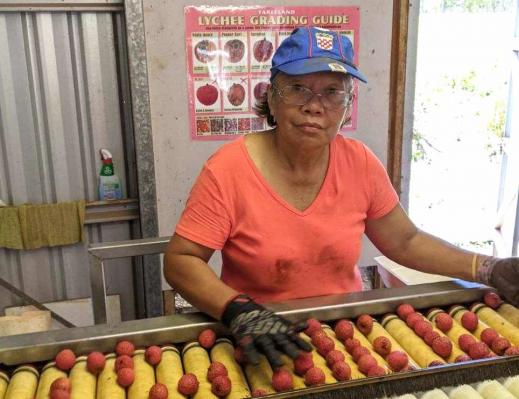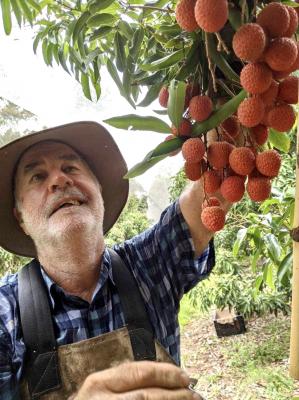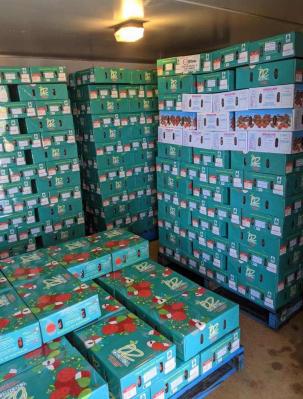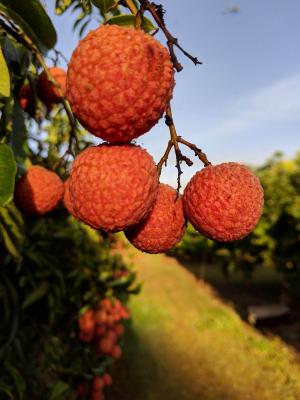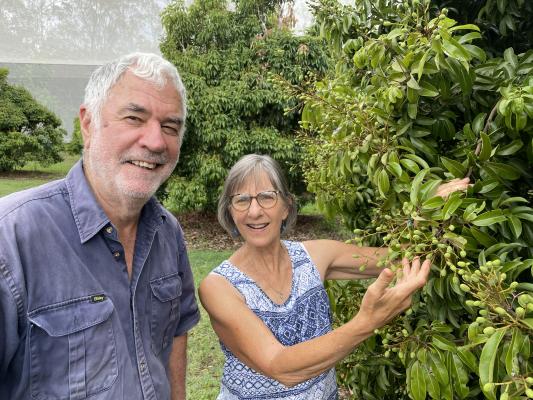
You wouldn’t read about it … from rubber plantations in Malaya and fighting mad cow disease in the UK, former Drouin residents Scott and Flora Sturgess have taken to growing lychees at Goomboorian. ERLE LEVEY, a veteran journalist who grew up in Kooweerup and now lives on the Sunshine Coast caught up with them recently.
When you sit down with a farmer you are never quite sure where the conversation will go. Where it will start and where it will take you.
That was the case with Goomboorian lychee farmers Scott and Flora Sturgess.
At the beautiful old pine table on the veranda of their home, they tell me about their life journey that has brought them to this tranquil 13ha property.
Over a cup of freshly brewed coffee and delicious home-made orange cake they remind me of how we build up a set of skills and adventures in life.
And how apt the six degrees of separation are. When a conversation gets going you realise how lives so easily overlap and how knowledge gained can easily be shared.
The places they’ve been, the people they’ve met.
While Scott was born on a grain and cattle property at Chinchilla, Flora grew up on her grandfather’s rubber plantation in Malaya.
It was the time of the Malayan Emergency, an uprising that eventually led to the formation of modern-day Malaysia.
Her father was managing the plantation and she would fly back to Australia to attend boarding school.
The insurgency was all around them in Perak state, in the north west of Malaya, and they would travel in convoys.
Her father had to sell the plantation after independence.
“We all had to leave Malaya really,’’ Flora said, “but he was ready to retire.’’
He had bought a place at Warwick and Flora spent a couple of years at school there before going to Brisbane.
That was business college which has stood her in quite good stead throughout life.
Scott had five elder brothers and he studied veterinary science at the University of Queensland.
Among the lessons he learned was how much easier it was for city kids to attend university.
It’s different if you are from the bush, you have to afford to board for a start. Yet Scott relied on a scholarship from the state government to get him through.
That set him on a path that has taken them across Australia and around the world.
The different people they have met and places they have been to has prompted Scott to write a book – Trust Me, You Couldn’t Make This Up.
It catches the thread of his life. Stories that other people have told him.
Scott served in Vietnam after being called up in the national service draft.
He was in the infantry but it was suggested because he was a vet he should have been posted to the tracker dogs unit.
That would have seen him caring for the black labrador tracker dogs at the Ingleburn Infantry Centre, NSW.
“If I’d had enough brains … if I’d had any brains I would have volunteered to look after them,’’ he said.
Instead he was given a driver’s licence and deployed overseas with the Australian Army training team of South Vietnamese ground forces, who were known as ARVN.
That was in 1970 and he was driving for the major who installed the Mobile Advisory Training Teams (MATT) throughout South Vietnam.
On his return to Australia, Scott went into veterinary practice in Victoria.
He was based at Drouin in West Gippsland. It was a mixed practice, dealing mostly with dairy cattle and small animals.
“We wanted to have a practice of our own and realised we needed to look somewhere there was not an existing one.
“Funnily enough, there was an ad in the Australian Veterinary Journal from the Chamber of Commerce at Alice Springs.
“They were offering subsidised accommodation to set up there.
“We thought very seriously about it but Flora already had ageing parents, a baby and another on the way.’’
Instead they went to Wauchope, a timber town in the Mid North Coast region of New South Wales.
Scott had been having a good run with race horses as an owner.
Eventually they went back to Warwick, bought a property and he took a trainer’s licence out.
“He went there to tidy up his parent’s estate,’’ Flora said, “then we would be going travelling.
“But he fell in love with the town and we stayed.’’
Horses took over and, as Scott said, they fooled around for a couple of years before buying a dairy farm.
He thought: “What have I got myself into.’’
That led to a role as a government veterinary officer with the Department of Primary Industry at Roma.
It was 1984. Two years later they were back in Charleville and by 1988 were in Cairns.
“Charleville was for TB eradication in cattle,’’ Flora said. “So was Cairns.’’
The Cairns region stretched from Cardwell, west to Normanton, and north to the tip of Cape York.
It was mostly to do with TB eradication.
“The easy jobs had been done,’’ Scott said, “so we were doing the difficult ones in the areas that had been left behind.
“We had helicopters … 12 at one stage … to try and meet a deadline.’’
That was especially while they were working in the Cape York peninsula.
“It was a blessing in disguise,’’ Flora said.
“They restocked the country with Bos Indicus cattle – they are more tick resistant.
“So out of a drastic situation came an unexpected bonus.’’
Things turned around with the change of government in 1989, Scott said. And his interest in land and sustainability came to the fore, thanks to the skills and interests he had picked up.
“Wayne Goss was premier and you could see the way things were going so I went to Brisbane to be executive officer of the Queensland Landcare Council.
“It was a government and community body for Landcare Queensland.’’
Scott became manager for Catchment Management in Queensland’s southern region … in reality the Queensland catchment of the Murray Darling river basin.
The role was about developing principles of management for the long-term betterment of the land in general.
Another change of government saw Scott stand for parliament in Cairns.
He was unsuccessful but became policy advisor for Minister for Natural Resources, Howard Hobbs.
That was during the Rob Borbidge government and a new department was created – a combination of water resources, conservation and lands department.
That saw a forestry management tour with the Queensland Timber Board in 1997 to Canada and Europe.
In Canada their guide was Patrick Moore, who formed Greenpeace, and Scott described as “an exceptional bloke.’’
The tour included England, Scotland and Sweden.
That was another lesson Scott learned.
“At the start of the 20th century Sweden looked at a national decision to grow trees.
“Now there are thousands and thousands of individual forests … there are 30,000 members growing trees.’’
The upshot of the study tour was the minister was rocked by a scandal and forced to stand down.
Scott went back to the United Kingdom as mad cow disease had broken out.
Vets were being attached to meat works to make sure they were only culling unhealthy animals.
“It was a bugger of a job but it was an interesting time,’’ Scott said. “It taught me some interesting things.
“As an Australian, class distinction is something you do not contemplate yet it is ingrained in their system.’’
Their time in the UK meant that Flora, being a Macdonald, could connect with a line of her family on the Isle of Skye.
She recites a poem her mother would share:
“There’s no bad weather on the Isle of Skye,
“If it’s wet, it’s warm,
“If it’s cold, it’s dry.’’
About the same time, a stock inspector in Charleville, who had been a regional manager in Western Australia in the Gascoyne, turned up in London on a study tour.
“Why don’t you come back to Australia?’’ he asked Scott.
So they went to Carnarvon where Scott would be manager of industry development in the southern rangelands.
The area was somewhat hard to describe but roughly it went from the Pilbara down to Kalgoorlie.
The Gascoyne role was to boost development in the area and promote the region.
Included was having an honest talk about what do on farms, improve properties and expand the economy.
When they returned to Brisbane, Flora got a job with language studies. Much of it involved teaching English to Japanese students.
“I’ve been lucky to work in so many places,’’ Scott said. “You learn so much more about a place than simply travelling.
“You see a country from the inside.’’
While Flora enjoyed the small communities in Western Australia she was pleased to be back home in Queensland.
They were able to buy a farm at Toowoomba and go up for the weekends.
They kept it until 2007 when they fluked a good time to sell and travelled for a bit before buying their lychee farm at Goomboorian.
Scott said they sat in Brisbane and asked: ’What are we going to do?’
“We wanted to get out of there … away from traffic and barking dogs.
“We found this property.
“We had been looking further north but the GFC had just hit and we came up to inspect the place.
“It was relatively close to Brisbane, and lychees seemed interesting.
“The year consists of two-to-three months serious work, five months of easy work and not much all for the rest of it.
“The 13ha is well drained and catches the easterly sun.’’
So, did they know what they getting themselves in for?
“Not really,’’ Scott said, “But that wouldn’t be a first.’’
Scott and Flora now have more than 750 lychee trees, and nearly all under netting to protect them from predators – such as fruit bats and lorikeets – and from storms.
“We thought we would not have to work very hard,’’ Flora said, “but you have to keep up with the plants and weeds.
“The trees will pretty much last forever, like mangoes, and grow to the sky if you do not prune them.
“There are four different varieties. The most common is Kwai Mae Pink, but also Salathiel, Wai Chee and another group, Sah Keng.
“We have just planted another 280 pinks – they are a year old.
“The mature trees were here 12 years ago when we bought the property.
“The younger trees have now been netted.
“We installed a very good cold room recently.’’
Hail is always a threat, Scott said, and he shows me photos of the nets weighed down so much they are almost touching the ground.
“You worry about it. While we have not had much in recent years there also has not been much rain.’’
Pruning of the trees to encourage new growth is done on a cherry picker.
The fruit is hand-picked by 15 or so locals.
“We only just had enough pickers last year,’’ Scott said. “We were worried we would not get enough.
“Pre-Covid we had plenty. Some are backpackers … even this year.’’
While most of the crop is sent to market there is potential for local consumption to increase.
The majority of the fruit goes to Sydney markets but some go to Cooly Fruit and to Gingers in Gympie.
They are thankful for the local support but also pleased to see Gympie people enjoying their fruit.
They also send some to Cairns for Rusty’s Bazaar, a long-standing market right in town.
“You have got to be here and do it,’’ Scott said, “but it’s not hard work.
“For six weeks each year, generally from early January, the farm sees a frenetic picking period.
“Last year we grew 31.5 tonnes.
“Christmas is optimum time for the fruit to go to market but we rarely pick before January for market.
“The season can start in October up in Mareeba while down at Coffs Harbour it can be as late as March.
“Last year we were able to have some ready for Christmas. Everything came a week or two early.
“This year, we are expecting smaller numbers. They tend to be one year on and one year off, so we are not expecting as heavy a harvest.’’
The characteristics of the fruit are simple: Delicious.
When refrigerated they are like enjoying cold lemonade on a summer’s day.
“Pinks are pretty much what you will buy in the shops,’’ Flora said.
“The Wai Chee are the last fruit to come ripe and are quite big, but they have a big seed and quite red.
“The Chinese love them as gifts.
“You can freeze lychees but mostly they are enjoyed fresh.
“When they are out on a table for a while the skin can discolour, but the fruit is excellent.
“They are so juicy. They last for ages.
“We refrigerate them to keep them blemish free.’’
Goomboorian is generally regarded as good farming country but it can be patchy – from river flats to loam and through to bushland.
Scott and Flora’s property has a variety of soils but mostly it’s beautiful red volcanic, and there is a large dam for irrigation.
The rainfall is generally consistent yet the past two years have been drier than usual.
“Too much rain … I can live with that,’’ Scott said. “The house is up on the hill.
“Wet summers save us having to use the dam.
“Since March last year there has only been one fall of rain in a day of more than two inches.
“Three years ago the crop was ordinary as it was half the rainfall.
“Last year, while not the run-off we usually have there was nearly the average annual rainfall.
“It’s been the same this year – no run-off, but it will change.’’
Lychees are regarded as having originated in China but neither Scott or Flora know how far back in history they go.
In Chinese cultures, they are considered the gift for a joyful life.
They have certainly lived up to that for Scott and Flora.

